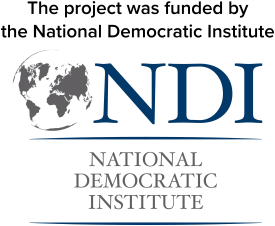Looking for an audience. How TikTok’s new policy has “cut” the audience of Russian propagandists abroad
On May 23, TikTok announced an update to its policy against targeted influence campaigns: from now on, all channels labeled as “state-controlled media” will not appear in recommended videos outside their country of origin. Thus, Spanish-speaking RT will not appear in the recommendation feed for the Spanish-speaking audience, and Sputnik Brasil will not appear for the Brazilian audience. But does this restriction work effectively? We decided to check the data.
We joke in the editorial office: the period of intensified improvement of the anti-disinformation policy on TikTok suspiciously coincides with the onset of pressure on the platform in the United States. But regardless of the root causes, we must state that since the beginning of this year, TikTok has not only been more actively working in favor of Ukraine but has also joined the global concern about its potential to influence elections worldwide, not just in the U.S.
As stated on the platform, in the first months of 2024, TikTok's efforts detected and neutralized 15 influence campaigns, deleting 3,000 associated accounts. Although this seems insignificant compared to last year's Russian bot farm with 12,800 accounts, it is still better than nothing.
Cleaning TikTok in Ukraine
The efforts did not stop at neutralization. Already in April, TikTok began officially cooperating with the Center for Countering Disinformation—at its request, it removed 24 hostile propaganda channels (among which were manipulative anti-Ukrainian channels like Stakhov, Shariy, and Dubinsky), and some Russian propagandist media channels were restricted from access within Ukraine.
Therefore, today, if we look at the number of views for each video of the TikTok channel "RIA Novosti" (one of the few Russian propagandist media that did not reduce their activity on TikTok after the platform's operation was restricted in Russia since March 2022), we will see a significant decrease in the audience after April 18, 2024—the day the new restrictions were introduced in Ukraine. Hence, their videos no longer reach the Ukrainian audience, at least in territories controlled by Ukraine, as they do not appear in recommendations or search results (previously, they could appear even in search results for "neutral," non-war-related hashtags).
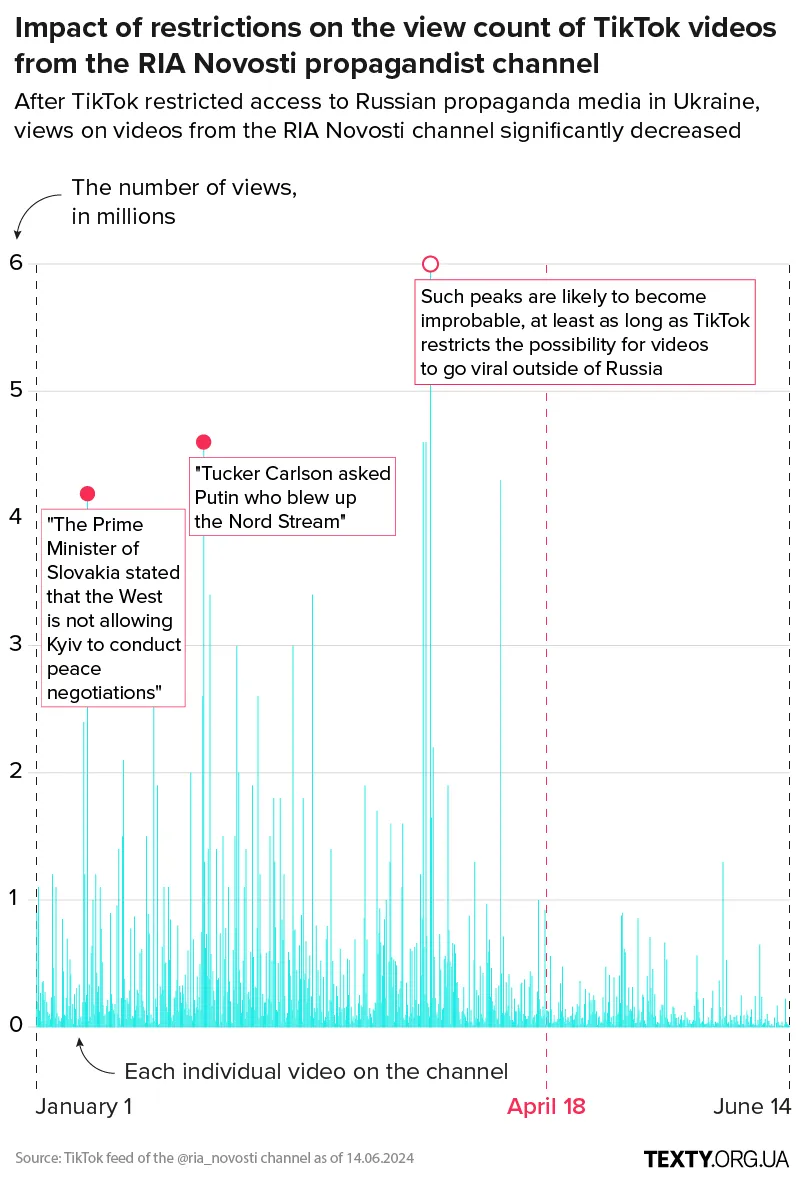
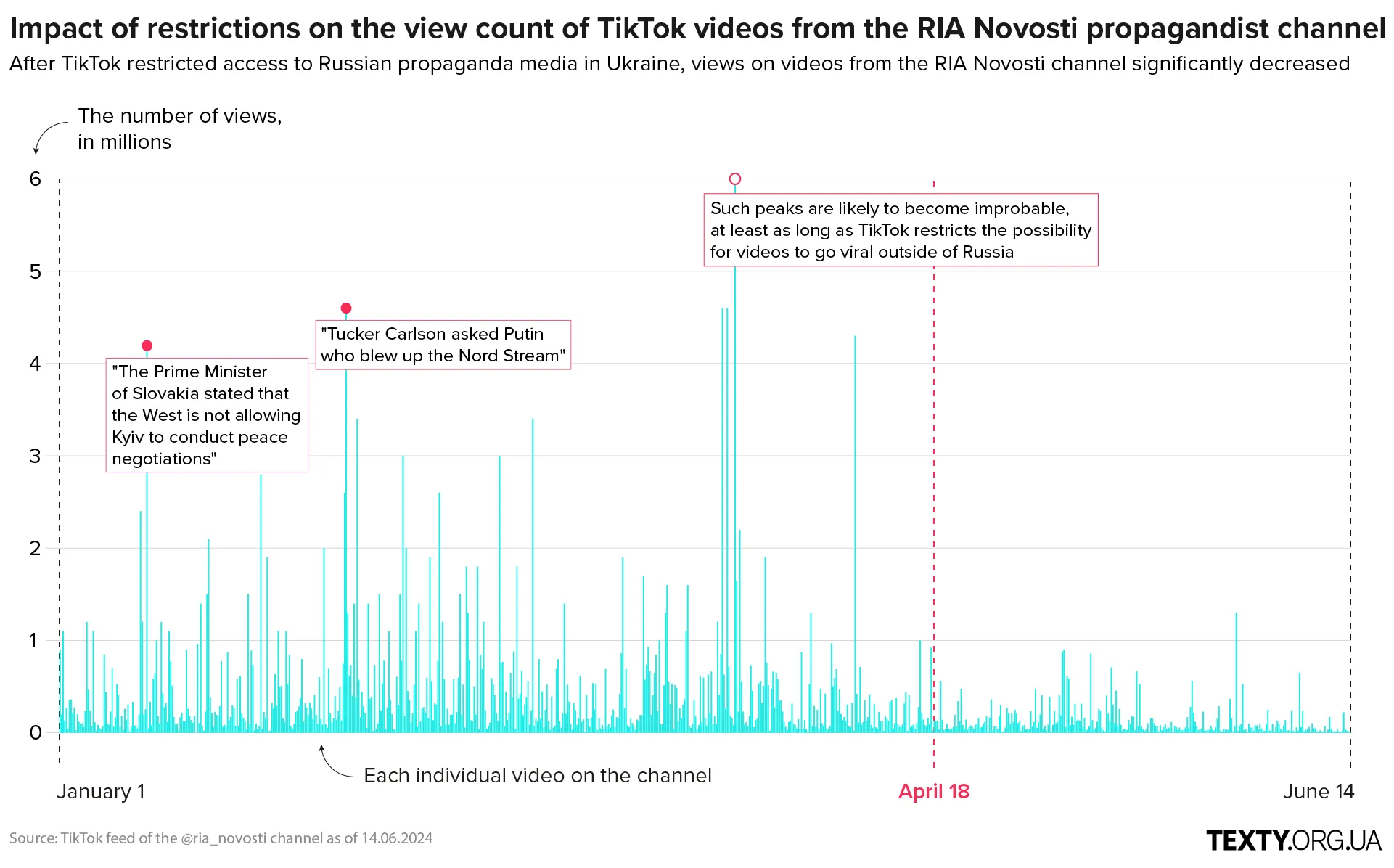
And this story could already be considered partially successful if all of Russia's public propaganda activity on TikTok was limited to just one Russian-language account.
Reducing Russia's global influence?
As of March last year, researchers noted a network of official Russian propaganda media on TikTok, which comprised 78 accounts (47 of which were labeled by the platform as "state-controlled by Russia"). At that time, these accounts had over 14 million followers and over 319 million likes (and, correspondingly, tens of times more views).
Not all of them continued their activity after 2022 when TikTok suspended streaming and posting new videos in Russia, but some channels became effective tools for spreading Russian messages. Moreover, they began to increase their reach and activity.
As of early June, the TikTok channel Sputnik News Latin America, for example, has 680,000 followers and over 20 million likes. And Sputnik Kyrgyzstan, despite TikTok being blocked in the country since April this year, continues to create new content on two channels (one in Russian, the other in Kyrgyz), both of which together already have 1.4 million followers and 81 million likes.
If the newly announced TikTok restrictions are indeed working, their effectiveness should already be impacting the reach of Russian propagandists today. Now, their videos can only be viewed via direct links, by visiting their channel, or in your subscription feed (if you were previously subscribed). This means these videos lose the potential to go viral and reach a new audience beyond existing subscribers.
One problem is that it's challenging to research recommendation algorithms (as we found when investigating YouTube). While it's possible to track what the platform recommends, it's almost impossible to assert with 100% certainty that something is definitely absent from the recommendations.
Therefore, we took a different approach — we extracted information about all the videos from this year from 14 active TikTok channels labeled "state-controlled by Russian media" and tried to see if the average number of views changed before and after TikTok's new anti-influence policy was implemented.
We identified Russian TikTok channels labeled “state-controlled media (Russian Federation).” From these, we selected those that had published more than 100 videos since the beginning of 2024, with at least 20 of them posted after May 23, 2024. This gave us a list of 14 channels: actualidadrt, ria_novosti, rtarabic.ru, rtenmaghreb, rtmexico, sputnik.brasil, sputnik.indo, sputnik.kg, sputnik.kyrgyzstan, sputnik.mundo, sputnik_news, sputnikarmenia, tvrussia1, vesti.ru.
For these channels, we calculated the average number of views for an equal number of videos published before and after May 23, 2024. For example, if a channel published 50 videos after May 23, we compared the average number of views for these with the 50 videos published before May 23. We calculated the average (not the median) because the average is more sensitive to outliers (in our case, situations where individual videos gained significantly more views than the rest, i.e., went viral).
We downloaded the list of videos and their view counts as of June 14, 2024. In total, we analyzed around 9,000 videos.
Important Note: We cannot be certain that we are dealing with the final view counts. Since the restrictions were implemented less than a month ago, there is a possibility that the latest videos simply haven't yet "reached" their full audience.
However, the chances that the restrictions are already having a direct impact have increased—on 12 out of 14 channels, the average number of video views has indeed decreased.
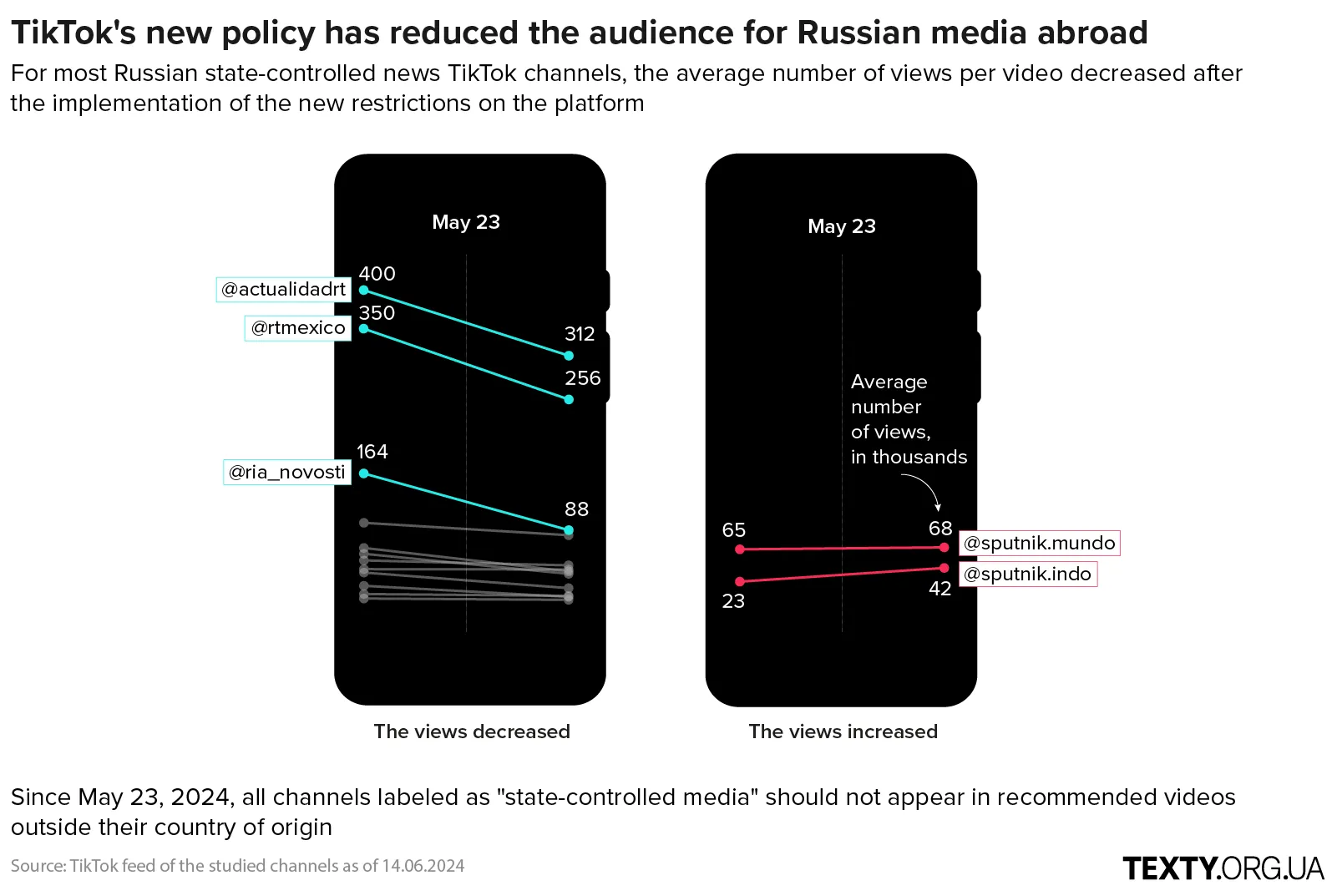
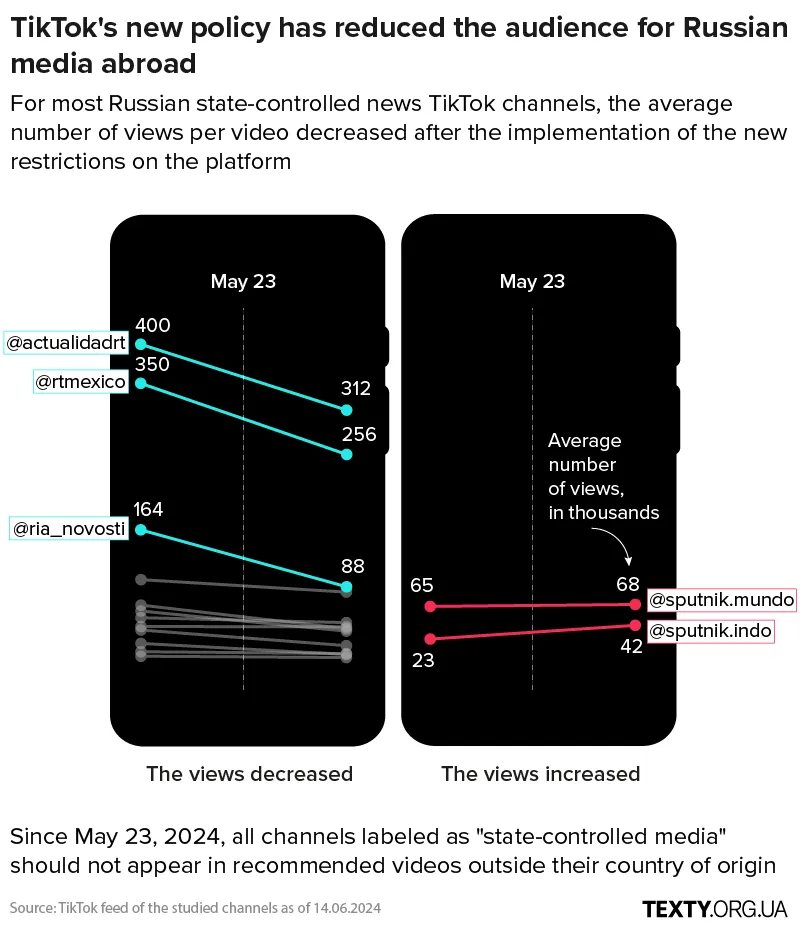
It seems that the restrictions on Russian propaganda media on TikTok are working and will at least complicate the promotion of Russian narratives abroad in the future.
However, many questions remain. Let's try to answer some of them.
Is there a risk that these restrictions will work against quality (but government-funded) media?
In its methodology, TikTok notes that it considers not only the fact of government funding but also the lack of editorial independence (link). We found no examples of government-marked but professional media. In case of erroneous labeling, an appeal can be submitted.
Can it be assumed that Russian influence on TikTok will gradually decrease?
This could be assumed if Russian information campaigns were limited to public Russian media accounts. However, repeated exposures of massive Russian bot farms show that Russian narratives are spread not only openly. It seems that Russia will continue to invest even more resources and funding in various TikTok campaigns, as this platform remains one of the least regulated and transparent while also growing the most dynamically — both in the US and in Ukraine.
What could be improved in this policy?
The described restrictions apply only to the media channels themselves. However, the channels of their editors or people affiliated with them are not subject to any restrictions. For example, today, Margarita Simonyan's personal channel has no labels indicating its affiliation with official Russian propaganda. Thus, it can easily retransmit RT content and appear in recommendations in any country (except perhaps Ukraine, where her channel is blocked).
Can TikTok already be considered more transparent and responsible? (And thus, for example, no longer create petitions for its blocking)
One effective restriction still means little against the backdrop of many problems with TikTok. Its Chinese origin (and the associated possibility of user data being transmitted to the Chinese government) is compounded by many ambiguous decisions and actions. For example, TikTok recently restored the ability for Russian citizens to upload and view new videos. Conversely, it restricted the functionality of the TikTok Creative Center (a tool for tracking trends and hashtags on the platform) when it began to be used to highlight content moderation issues. In early June, TikTok showed the worst result in a test of social networks' ability to detect disinformation about EU elections. In Ukraine, this social network has blocked some accounts, but not all of them from the list of propaganda channels provided by the Center for Countering Disinformation.
What about the occupied territories? Does protection from Russian propaganda on TikTok work for users in Mariupol, for example?
Most likely, TikTok's algorithms prioritize IP addresses over geolocation. Thus, using the internet from a Russian provider or communication operator "turns off" the restrictions implemented in Ukraine. As a result, propaganda videos face no barriers to spreading in the occupied territories. However, we cannot confirm or refute this hypothesis.
We continue to publish a series of materials on the role of TikTok in Russian information campaigns in Ukraine and the occupied territories. To avoid missing out, subscribe to our newsletter.
This article was originally written in Ukrainian. It has been translated into English using AI tools such as DeepL, ChatGPT, and Grammarly. If you encounter an error that requires immediate attention, please inform us via Facebook, Twitter, or Instagram. Your understanding and support are appreciated.
